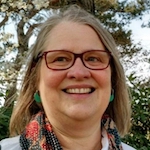Congratulations, Karen Stanbary, CG!
-
Created on 02 May 2016
“My passion for genealogy began as a high-school senior watching the Roots mini-series on TV,” says Karen Stanbary. In the early 1980s, the show inspired her to “take a local community-college class, explore the collections at Chicago’s Newberry Library, and (best of all) interview my grandparents, their siblings and my great-grandmother.” Karen borrowed a mimeograph machine to create family group sheets and pedigree charts.
Decades later, faced with an empty nest, she returned to her passion and stumbled upon two articles that questioned the validity and reliability of Alex Haley’s work.[1] Feeling a bit betrayed, she resolved to learn valid genealogical methods. That combination of inspiration and critique bore fruit, and in April she qualified to become Certified Genealogist #1071.
Karen Stanbary, CG
Karen was born in Burlington, Iowa, where many of her deceased ancestors remain. She grew up in a western suburb of Chicago. She and her husband currently practice specialized clinical social work in Chicago. She is fluent and literate in Spanish and completed graduate anthropological work in Mexico, one of her genealogical areas of expertise. She teaches three twelve-hour seminars for the Newberry Library’s Adult Education program: Genetic Genealogy, Genetic Genealogy–Advanced Practical Applications, and Proving Your Pedigree. She will teach in the Practical Genetic Genealogy course at the Genealogical Research Institute of Pittsburgh (GRIP) this summer.
Karen credits her successful portfolio in large part to the teachings and guidance of Tom Jones, PhD, CG, CGL, Elizabeth Shown Mills, CG, CGL, Sandra Hewlett, CG, Debbie Parker Wayne, CG, CGL, Blaine Bettinger, PhD, JD, CeCe Moore, Angie Bush, MA, and Jeanne Larzalere Bloom, CG. Her experience in the ProGen Study Group, Mastering Genealogical Proof Study Group, and NGSQ (National Genealogical Society Quarterly) Study Group—as well as classes at GRIP, Salt Lake Institute of Genealogy, and Institute for Genealogical and Historical Research (IGHR)—also improved her genealogical critical analysis skills.
Karen especially wants to thank Harold Henderson, CG. “He is a fantastic mentor who helped keep me accountable to my timeline. He provided just the right balance between understanding and accountability.”
She committed to the certification process and created a routine. “Early each morning, when my brain works best, I would spend focused quality time with my portfolio. I prepared a 'portfolio space’ with all the essential materials at hand—the BCG Application Guide, Chicago Manual of Style, Evidence Explained, Genealogy Standards, Numbering Your Genealogy, and the IGHR writing course syllabus. I bought a second monitor so I could see the docs on one screen and write on my laptop.
“And I took the time to dig deep into the records. Doing that helped me to keep the Kinship Determination Project (KDP) interesting. I spent three years with the KDP family. I think I would have become bored with them without those unusual records and social histories. And a bored writer does not write.
“It was a significant breakthrough to realize that one size does not fit all—that there is no universal template or formula. Within the standards, I had to learn to trust my own decision-making, to feel the freedom to tell the story.”
Karen’s case study identifies the Mexican father of a Michigan adoptee using documentary research, interviews with potential relatives, and analysis of nine people’s autosomal DNA test results, including triangulated matches. This work is contracted for publication in the NGSQ.
How much overlap is there between clinical social work and professional genealogy? “More than I expected, especially in genealogy cases with real present-day emotional impact, such as unknown paternity, misattributed paternity, the appearance of previously unknown half-siblings, and adoption cases.” And the skill sets are similar: “Both require the careful creation of timelines, critical consideration of the source(s) of information, and empathy—the ability to step out of one’s cultural comfort zones in order to view events through the participants’ eyes.”
What’s next for Karen? She plans to teach and to increase her client work, especially helping people solve family mysteries and break through brick walls using a combination of documentary research and targeted DNA testing. “It’s an exciting time to be a member of the genealogy community.”
Karen can be reached at karenstanbary@gmail.com.
[1] Elizabeth Shown Mills and Gary B. Mills, “Roots and the new 'Faction’: A Legitimate Tool for Clio?” The Virginia Magazine of History and Biography 1 (January 1981): 5–26. Also, Elizabeth Shown Mills and Gary B. Mills, “The Genealogist’s Assessment of Alex Haley’s Roots,” National Genealogical Society Quarterly 72 (March 1984): 35–49. Both articles can be viewed at Historic Pathways.
